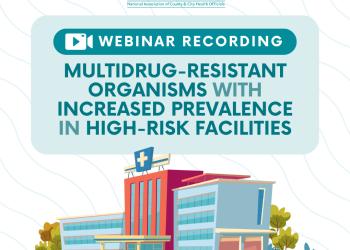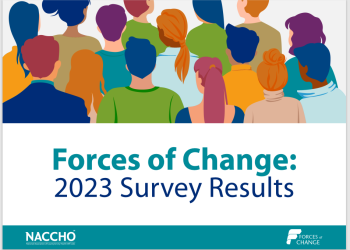 Every day 4,000 people worldwide die from viral hepatitis, yet all of these deaths are preventable. With increased awareness, resources, support, and commitment, we can prevent and treat viral hepatitis and put an end to these epidemics. To raise awareness of the 400 million people worldwide living with hepatitis B or C, the World Health Organization marks World Hepatitis Day on July 28, emphasizing that eliminating viral hepatitis mortality is a winnable goal. Local health departments play a pivotal role in preventing, monitoring, and detecting viral hepatitis and linking individuals with viral hepatitis to care.
Every day 4,000 people worldwide die from viral hepatitis, yet all of these deaths are preventable. With increased awareness, resources, support, and commitment, we can prevent and treat viral hepatitis and put an end to these epidemics. To raise awareness of the 400 million people worldwide living with hepatitis B or C, the World Health Organization marks World Hepatitis Day on July 28, emphasizing that eliminating viral hepatitis mortality is a winnable goal. Local health departments play a pivotal role in preventing, monitoring, and detecting viral hepatitis and linking individuals with viral hepatitis to care.
Hepatitis C virus (HCV) is the most common blood-borne infection in the United States and the leading cause of liver cancer and liver disease. An estimated 3.5 million Americans are living with chronic HCV and annual death rates surpass those from HIV. There is not yet a vaccine for HCV and it is a growing issue for public health and the healthcare system. New infection rates among persons aged 15-24 are increasing and morbidity and mortality among those already infected are rising.[1]
Many persons with HCV were infected decades ago, before implementation of prevention measures in healthcare systems (namely screening of the blood supply), and most are unaware of their infection. Persons born during 1945–1965 (i.e., baby boomers) have a fivefold higher risk of HCV infection than other adults and the CDC recommends HCV testing for everyone in this group. CDC also recommends testing for people who currently or formerly injected drugs and people living with HIV. Most newly diagnosed HCV cases are associated with injection drug use and one quarter of HIV-infected persons in the United States are also infected with HCV.[2]
Improved antiviral treatments make HCV diagnosis and linkage to care a priority. New treatments for HCV are curative, of short duration, interferon-free, and have few side effects. However, persons infected with HCV will only benefit from therapeutic advances when they are identified and linked to care. Local health departments are uniquely positioned to help fill this need and are on the frontlines of new opportunities to expand HCV testing and access to care and treatment.
Diagnosing HCV infection requires two tests, a screening antibody test followed by an RNA test. A positive or reactive hepatitis C antibody test means that a person has been infected with HCV at some point in time. However, a positive antibody test does not necessarily mean a person still has HCV. For reasons that are unknown, 20% of people who receive a positive antibody test will clear the virus on their own in the first six months.[3] An additional test, called an RNA test, is needed to determine if a person is currently infected with HCV. National surveillance data show that almost half of patients with a positive antibody test do not receive the recommended RNA test to determine infection status. Local health departments are critical leaders and partners in efforts to increase HCV RNA testing among persons who are HCV antibody positive.
In New York City, the Department of Health and Mental Hygiene (DOHMH) conducts educational follow-up by mail with people who have been reported to the health department as HCV antibody positive, but who do not have a reported RNA test result. This strategy is supported by an advanced surveillance system, including effective electronic lab reporting of both RNA positive and negative tests. In July 2014, NYC made a change in the health code to make negative RNA tests reportable to the health department, which greatly improved the ability to identify individuals who have never received RNA testing.
Unfortunately, surveillance for HCV is considerably lacking across the country. Additional strategies implemented by NYC DOHMH provide examples of other types of actions local health departments can take to increase HCV RNA testing, including: encouraging laboratories to stress the importance of RNA testing when providing reactive antibody results; educating clinicians on the availability of HCV reflex testing, where the laboratory immediately performs the RNA test on the same specimen if the antibody result is reactive; providing technical assistance to improve RNA testing rates at Federally Qualified Health Centers; sending a letter from the Health Commissioner to clinicians highlighting the need for RNA testing, along with other key updates on HCV diagnosis; and employing community advisory groups to explore challenges and solutions to RNA testing in various settings.[4]
Another example of what local health departments are doing to increase RNA testing comes from Durham, NC. In December 2012, the Durham County Department of Public Health initiated HCV antibody with reflex RNA testing. Testing facilities include the STD clinic, county jail, community testing sites (including a residential substance abuse recovery program), and a homeless clinic. In the jail setting, universal opt-out HCV testing is offered. In the other settings, targeted HCV testing is offered to patients based on the CDC’s birth cohort (1945-1965) testing guidelines and other risk factors, such as injection drug use or HIV infection. Persons diagnosed with chronic HCV infection are then linked to HCV care by an HCV “Bridge Counselor” (i.e., patient navigator). The counselor also provides education, incentives, and transportation. Results from this program demonstrate that expanded HCV testing through public health programs can identify a significant proportion of patients with chronic active HCV infection; however, additional measures are needed to enhance linkage to care. Despite the Bridge Counselors and on-site HCV clinics, only 49% of persons with chronic HCV infection were linked to care.[5][6]
HCV testing, care, and treatment are critical for ending the epidemic. To learn more about how local health departments can support HCV testing and linkage to care, view NACCHO’s Web-based educational series on local health departments and hepatitis C.
- Centers for Disease Control and Prevention (2011). Hepatitis C Virus Infection Among Adolescents and Young Adults — Massachusetts, 2002—2009. Morbidity and Mortality Weekly Report, 60(17); 537-541. Retrieved July 21, 2015, from http://www.cdc.gov/mmwr/preview/mmwrhtml/mm6017a2.htm.
- Centers for Disease Control and Prevention (2015). Viral Hepatitis – CDC Recommendations for Specific Populations and Settings. Retrieved July 21, 2015, from http://www.cdc.gov/hepatitis/populations/hiv.htm.
- Centers for Disease Control and Prevention (2015). Hepatitis C: General Information. Retrieved July 21, 2015, from http://www.cdc.gov/hepatitis/HCV/PDFs/HepCGeneralFactSheet.pdf.
- Bornschlegel, K. (2014). Strategies to increase hepatitis C RNA testing for persons with a positive antibody test result. Presented at the 2014 Council of State and Territorial Epidemiologists Annual Conference. Retrieved July 21, 2015, from http://bit.ly/1LT4su9.
- Sena, A., Hilton, A., Muir, A., Hurt, C., & Wohl, D.A. (2015). Expanded testing for hepatitis C virus infection in a public health department and linkage to care in Durham, North Carolina. Presented at the 2015 National Summit on HCV and HIV Diagnosis, Prevention and Access to Care. Retrieved July 24, 2015, from http://www.hivforum.org/storage/documents/2015/Summit/Presentations/A1_10_Sena.pdf.
- Sena, A., Hilton, A., Muir, A., Hurt, C., & Wohl, D.A. (2015). Expanded testing for hepatitis C virus infection in a public health department and linkage to care in Durham, North Carolina. 2015 National Summit on HCV and HIV Diagnosis, Prevention and Access to Care Final Program and Abstract Book, p. 32-33. Retrieved July 27, 2015, from http://www.hivforum.org/storage/documents/2015/Summit/ebook_nationalsummit2015.pdf.






